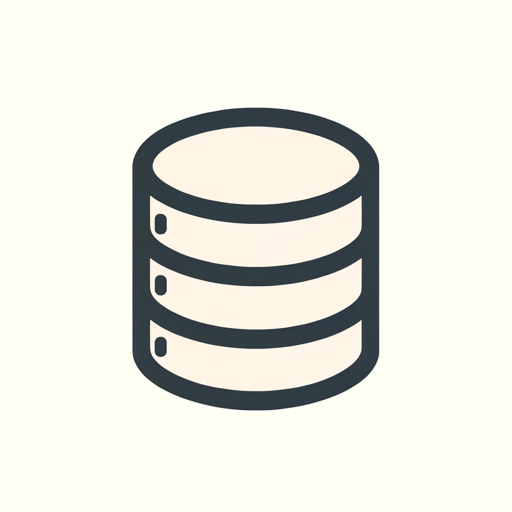Database Design Helper-SQL database schema assistant
AI-powered tool for optimized SQL database design.
Help me design a database schema for my store.
Explain the use of indexes in a database.
How do I optimize my SQL queries?
What are best practices for managing a large e-commerce database?
Related Tools
Load More
Database Designer
This GPT can provide guidance on database schema design, SQL queries, data normalization, database optimization, and handling various database management systems (DBMS) like MySQL, PostgreSQL, and MongoDB.
Database Architect (+Database Visualization)
Database Expert GPT: Design Databases + 🔴VISUALIZE IN-CHAT🔴+ Optimize queries, Create Normalized Database structures and more. For: SQL, Oracle, Salesforce, GA4

SQL Database Architect
Expert in SQL DB design with the ability to print ER diagrams

PostgreSQL Assistant
Expert in PostgreSQL data modeling and querying.

Database Expert
Advanced database engineer: schema design, SQL queries, data normalization, and database optimization. Works with multiple database management systems (DBMS) like PostgreSQL, MySQL, SQLite, MongoDB, BigQuery, Oracle and others.
ER Diagram Assistant with graphics
Helps in creating ER diagrams for business processes and display them with the help of an external API
20.0 / 5 (200 votes)
Overview of Database Design Helper
Database Design Helper is designed to assist users in creating efficient, scalable, and well-structured SQL database schemas, with a focus on e-commerce platforms. Its core functions include helping users make informed decisions on table structure, data types, relationships, and indexing strategies. The system is tailored to guide users through best practices in database management, query optimization, and troubleshooting. For instance, if you're designing a database for an online store with products, customers, and orders, Database Design Helper can provide recommendations on how to organize these tables, establish foreign key relationships, and create indexes that speed up queries such as customer order history retrieval. It also supports complex decisions like normalization, denormalization, and partitioning, depending on the specific use case and performance needs.

Key Functions and Applications of Database Design Helper
Schema Design and Structure
Example
Designing an e-commerce database where products, customers, orders, and payments are all linked through appropriate foreign key relationships.
Scenario
A user needs to design a scalable database for an online retail platform. Database Design Helper advises on structuring tables to avoid redundancy, ensuring that orders are linked to customers and products through foreign keys, and choosing the right data types for storing information like product prices, stock counts, and order timestamps.
SQL Query Optimization
Example
Optimizing a query that retrieves a customer's entire order history by suggesting indexes on foreign keys and critical columns.
Scenario
A retail platform is experiencing slow performance when fetching a customer’s order history. Database Design Helper suggests creating an index on the 'customer_id' and 'order_date' columns in the 'orders' table to speed up queries. This is followed by recommendations on writing efficient SQL JOINs between tables like 'customers', 'orders', and 'order_items'.
Normalization and Denormalization
Example
Helping decide when to normalize product and category data into separate tables or denormalize for performance gains in read-heavy applications.
Scenario
In an application with millions of product entries, the decision to normalize product data (by storing category and supplier information in separate tables) or denormalize it (keeping category info within the products table) becomes crucial. Database Design Helper evaluates the trade-offs, suggesting normalization for easier maintenance or denormalization for faster read operations, depending on whether the app is read-heavy or write-heavy.
Target Audience for Database Design Helper
E-commerce Platform Developers
Developers creating or managing databases for e-commerce systems benefit from Database Design Helper by receiving specific guidance on structuring tables like customers, orders, products, and inventory. They can optimize their systems for high traffic, data consistency, and query performance, especially in platforms where data grows quickly, and performance is critical.
Database Administrators (DBAs) and Analysts
Database administrators responsible for maintaining, optimizing, and scaling existing databases in enterprise environments can use Database Design Helper to improve performance, troubleshoot issues, and design better indexes. Data analysts working on reporting queries or extracting insights from databases can also benefit from advice on how to optimize complex queries and ensure their data structures support fast, reliable analytics.

How to Use Database Design Helper
1
Visit aichatonline.org for a free trial without login, also no need for ChatGPT Plus. The tool is readily available for use, making it easy to access without the need for extra subscriptions or registration.
2
Prepare your database design query or use case. Ensure you have an understanding of your project's schema requirements, including the data you wish to model, the relationships between entities, and any specific SQL functions you'd like to implement.
3
Interact with Database Design Helper by asking detailed schema design questions. You can inquire about normalization, index creation, or optimizing table relationships for e-commerce or other platforms. Provide clear use cases for more specific responses.
4
Receive detailed responses and recommendations for your database schema. Use the suggestions to refine your SQL tables, relationships, or queries. The tool will guide you through best practices for efficient and scalable database design.
5
Apply the advice provided. Once you've generated or adjusted your database schema, implement it in your SQL environment. Use the optimization and performance tuning tips to further enhance your database structure.
Try other advanced and practical GPTs
UI/交互设计专家
AI-Powered Assistance for UI and Interaction Design

School Report Assistant
AI-powered student report writing made easy.

PixVerse - Generate videos for free
AI-powered video creation from text

Discover Japan with Me
Explore Japan with your AI guide.

AI Latviski
Your AI-powered Latvian language assistant.

Multiple Personas v2.0.1
Your Multi-Skilled AI Expert for Every Task

South Parkify
Transform your photos into South Park characters with AI.

キャラデザメーカー ver.2 - Creative Character Designer
AI-powered Character Design

Code Companion Pro
Your AI-powered partner for code mastery

選び方.com
AI-powered product comparison and recommendations

Website Chat
Unlock website insights with AI power.

The Minimalist Entrepreneur
AI-powered strategies for minimalist entrepreneurs.
- Performance Tuning
- Database Design
- Error Fixing
- SQL Optimization
- Schema Planning
Frequently Asked Questions about Database Design Helper
What types of databases does Database Design Helper support?
Database Design Helper is versatile and supports most relational databases like MySQL, PostgreSQL, and SQLite. It provides guidance on SQL schema design, query optimization, indexing, and troubleshooting errors, making it suitable for any SQL-based project.
Can Database Design Helper help with performance tuning?
Yes, it can assist in optimizing your database performance by recommending indexing strategies, query optimization techniques, and table partitioning tips to improve the speed and efficiency of your SQL operations.
How can I use Database Design Helper for e-commerce platforms?
For e-commerce platforms, Database Design Helper can assist in designing efficient schemas to handle large product catalogs, customer orders, and inventory management. It also provides insights into normalization, foreign key relationships, and transaction handling.
Can Database Design Helper help me troubleshoot SQL errors?
Absolutely. It can guide you through common SQL errors, such as syntax issues, constraint violations, and performance bottlenecks, while offering advice on how to resolve them effectively.
Is Database Design Helper suitable for academic projects?
Yes, it's great for academic projects, providing step-by-step guidance on database design, normalization, and relational modeling, making it easy to implement structured, well-optimized schemas for research or coursework.